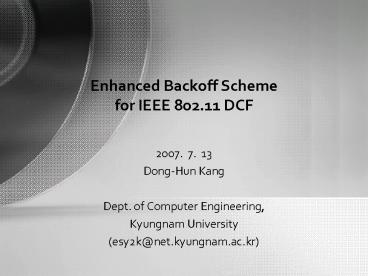Enhanced Backoff Scheme for IEEE 802'11 DCF - PowerPoint PPT Presentation
1 / 16
Title:
Enhanced Backoff Scheme for IEEE 802'11 DCF
Description:
... an unsuccessful transmission attempt, the CW is doubled and another attempt ... However, the original method is faster decreased than new method. ... – PowerPoint PPT presentation
Number of Views:76
Avg rating:5.0/5.0
Title: Enhanced Backoff Scheme for IEEE 802'11 DCF
1
Enhanced Backoff Schemefor IEEE 802.11 DCF
- 7. 13
- Dong-Hun Kang
- Dept. of Computer Engineering,
- Kyungnam University
- (esy2k_at_net.kyungnam.ac.kr)
2
Outline
- IEEE 802.11 WLAN Fairness Issue
- New Method 1
- New Method 2
- Simulation Result
3
IEEE 802.11 DCF
- It is based on carrier sense multiple access with
collision avoidance (CSMA/CA). - Before a station starts a transmission, it must
sense the channel idle for a duration, called DCF
interframe space (DIFS), plus an additional
backoff time. - Only when the channel remains idle during all
this time can the station initiate the
transmission. - The backoff time is an integer multiple of basic
time slot, drawn randomly between zero and the
so-called CW. - For each successfully received frame, the
receiving station immediately replies with an
acknowledgment frame (ACK). - After an unsuccessful transmission attempt, the
CW is doubled and another attempt with backoff is
performed.
4
IEEE 802.11 WLAN Fairness Issue
- It doesnt consider number of backoff
- It never consider to differentiate between many
transmission attempted station and first
transmission attempted station. - In spite of many long backoff time, transmission
opportunity is small. - That is short term unfairness.
- According to guarantee that fairness , IEEE
802.11 DCF need to improvement.
5
New method 1 Differentiated DIFS
- To supply fairness, we can use different DIFS
- Long DIFS is low priority, Short DIFS is high
priority - DIFS will change by number of backoff stage
6
New method 1 Differentiated DIFS (contd)
difs0 0.000050s (50ms)
0,0
0,CW0
CWmin_ 31 CWmax_ 1023 ShortRetrylimit_
7 LongRetrylimit_ 4
difs1 0.000045s
1,CW1
1,0
2,CW2
2,0
difs2 0.000040s
3,CW3
3,0
difs3 0.000035s
4,CW4
4,0
difs4 0.000030s
difs5 0.000025s
5,CW5
5,0
6,CW6
6,0
difs6 0.000020s
discard
gt ShortRetryLimit
7,0
difs7 0.000015s
- Default DIFS of legacy DCF is 50ms in DSSS.
- As Number of backoff increased, short DIFS is
matched.
7
New method 1 Differentiated DIFS (contd)
- For example, When Station 1 is at two backoff
stage and third transmission attempt, and when
Station 3 is at zero backoff stage and first
transmission attempt, - As DIFS decreased, many backoff stage and many
transmission attempted station have more
opportunity.
8
New method 2 Start Stage
- Start-Backoff Stage is not zero stage.
- Which Stage is Start-Backoff Stage ?
- End stage Start-Backoff Stage 6(Retry Limit)
- Start-Backoff Stage can move
9
Simulation Environment
- Simulator NS2
- Number of Station 10 70
- Performance Measure
- Throughput
- Delay
- Number of Backoff for each packet
- Simulation time 300s
- Simulation Parameter
- RTS-CTS option
- IEEE 802.11b MAC, PHY Parameter, DataRate 11Mbps
- Simulation Assumption
- There are always frames in the queue
- Simulation Object
- When fairness solved, we show performance measure
enhancement
10
Throughput
- As the number of station increasing, Saturation
Throughput decreasing. - However, the original method is faster decreased
than new method. - New method 2 is faster decreased than old
proposed method in 5
11
Average Delay
- As the number of station increasing, Total Delay
increasing. - However, the original method is faster increased
than new method.
12
Standard deviation of Delay
- As the number of station increasing, Total Delay
increasing. - However, the original method is faster increased
than new method. - Especially, new method 1 is the most slow
increased than others.
13
Bakoff for each packet
- As the number of station increasing, Backoff for
each packet increasing. - However, the original method is faster increased
than new method.
14
Successful Transmission Rate for each packet
- As the number of station increasing, successful
transmission rate for each packet decreasing. - However, the original method is faster decreased
than new method.
15
Reference
- 1 G. Bianchi, Performance Analysis of the IEEE
802.11 Distributed Coordination Function, IEEE
JSAC, vol. 18, no. 3, pp.535-547,March 2000. - 2 H. Wu et al., Performance of Reliable
Transport Protocol over IEEE 802.11 Wireless LAN
Analysis and Enhancement, IEEE Infocom, 2002. - 3 E. Ziouva and T. Antonakopoulos, CSMA/CA
Performance under High Traffic Conditions
Throughput and Delay Analysis, Computer
Communications, vol. 25, no. 3, pp. 313-321, 2002 - 4 S. Ci and H. Sharif, Evaluating Saturation
Throughput Performance of the IEEE 802.11 MAC
under Fading Channels, BROADNETS, pp.726-731,
2005. - 5 W. Kuo and C. J. Kuo, Enhanced Backoff
Scheme in CSMA/CA for IEEE 802.11, VTC, pp.
2809-2813, 2003 - 6 IEEE Standard for Wireless LAN Medium Access
Control (MAC) and Physical Layer (PHY)
Specifications, IEEE Std 802.11, 1999(R2003) - 7 IEEE Standard for Wireless LAN Medium Access
Control (MAC) and Physical Layer (PHY)
Specifications, Higher-Speed Physical Layer
Extension in the 2.4GHz Band, IEEE 802.11b, 1999
16
Thanks for your attentions.































